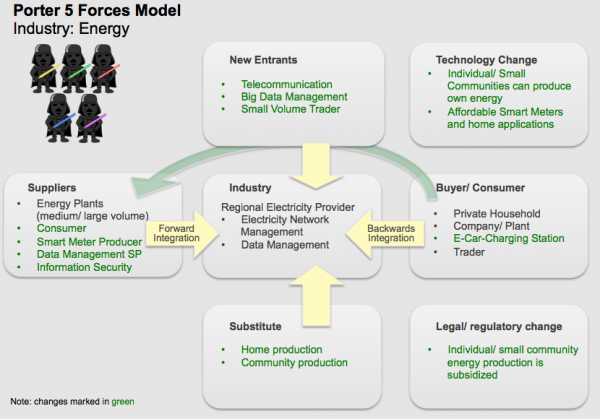WHAT COULD MAKE AN ENERGY GRID ‘SMART’?
Aren’t our current energy networks managed by information technology and able to distribute power in a smart way and as required (most of the time)?
So far, most of our energy gets produced somewhere centrally in only a few places, like a hydroelectric dam, a coal, gas, petroleum or a nuclear power plant. We are using a one-way distribution: from the place of production to the consumer.
New ways of generating energy, e.g. solar, wind, biogas… allow individuals or small communities to generate power. The consumer becomes the producer, a so called prosumers. Overcapacity of the small scale producers needs to feed back into the energy network. We would now need an energy network able to move electricity bi-directional.
Since the small scale suppliers can’t guarantee any levels of power generation (dependent on sunshine, wind….), the network is required to constantly balance the generation and consumption. Temporary overproduction needs to be stored for use in times of little or no production.
We might also use electric cars in the near future, and become a moving energy consumer who wants to connect to power sockets anywhere possible. The mobile energy user would have to be authenticated (similar to the user of a mobile phone) to ensure the electricity bill goes to the correct consumer.
Bi-directional feeding, balancing and consumer authentication make an energy network a smart grid.
How will this change the market of energy networks? A Porter 5 forces could look like this:
The market is expected to change massively:
- Substitution caused by new and affordable technology: solar, wind, biogas… allows power production of individuals and small communities, subsidized in many countries
- Affordable smart meter technology and home application software allow a better management of when and how much energy is consumed
- Backwards integration of the consumer: consumer is producing and selling energy
- New entrants:
- electricity network planning: existing and new companies specialized on smart grids
- electricity network rollout: new device manufacturer e.g. smart meter, electricity balancing devices with ambitions to forward integrate
- information network management: telecommunication companies, big data management service provider, information security companies, new regional associations
Many players are aiming for similar roles in the energy market. We should expect a healthy battle that will produce innovative solutions, new partnerships and a stable energy network at an affordable price.
The EU initiative EcoGrid connects 2,000 household on the Danish island Bornholm to test which pricing models balance fluctuating and less predictable renewable sources and flexible consumption.
Masdar City in Abu Dhabi is a pilot in testing sustainable technology including smart energy management. Irena, the international Renewable Energy Agency is also based here.
The International Electrotechnical Commission’s Technical Committee 57 for Power Systems management and associated information exchange TC 57, is working on standards for information exchange for power systems and other related systems like Energy Management Systems.
This blog was inspired by a visit to the E-World 2013 energy and water exhibition in Essen, Germany. The link leads to the list of exhibitors, their contacts and webpages. Might be useful for further research.

